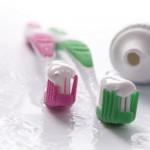
Regular toothbrushing twice a day with a fluoridated toothpaste is an important element of an effective oral hygiene. While the use of fluoridated toothpaste contributes to caries prevention some toothpaste contains ingredients to help remove staining or extrinsic tooth surface discoloration (ETD). ETD is caused by the retention of coloured substances in bacterial plaque, and the acquired pellicle or by chemical alterations of these organic integuments and various factors contribute including inadequate toothbrushing, smoking habits and the consumption of red wine, coffee or tea. Toothpastes often include abrasive systems to help remove staining and whitening toothpastes may include additional chemical discoloration agents to aid removal of ETD.
The aim of this review was to assess the effect of a whitening toothpaste compared with regular toothpaste on tooth surface discoloration.
Methods
Searches were conducted in the Medline, Cochrane Central Register of Controlled Trials (CENTRAL) and the EBSCO-Dentistry and Oral Sciences databases with no language restrictions. Randomised controlled trials or controlled clinical trials in patients over the age of 18 comparing whitening toothpastes to regular toothpastes and employing a measurement scale for extrinsic stain were considered.
Two reviewers independently screened and selected studies, extracted data and assessed methodological study quality using a 20-item checklist. An overall meta-analysis was performed on scores separated according to stain area, intensity and composite scores Two reviewers rated the quality of the evidence and the strength of the recommendations using GRADE
Results
- 21 RCTs involving 32 comparisons in 2355 analysed patients were included.
- 20 were considered to be a moderate risk of bias, and 1 at substantial risk.
- A majority (16) used a 6 week follow up period, two RCTs 8 weeks, and other 3 RCTs 12 weeks, 3 and 6 months respectively.
- Only 3 studies noted patients smoking habits.
- A significant difference for all aspects of staining was found in favour of whitening toothpastes.
- the difference of means (diffM) for staining area
- original Lobene Stain Index was −0.44 (95% CI [−0.55; −0.33]; P<.00001
- modified Lobene Stain Index was −0.41 (95% CI [−0.71; −0.10]; P=.009
- The overall diffM for staining intensity was −0.35 (95% CI [−0.44; −0.25]; P<.00001).
- For the composite score, the diffM was: –
- original Lobene Stain Index = −0.39 (95% CI [−0.57; −0.21]; P<.00001).
- modified Lobene Stain Index = −0.54 (95% CI [−0.66; −0.43]; P<.00001).
Conclusions
The authors concluded
In this review, nearly all dentifrices that are specifically formulated for tooth whitening were shown to have a beneficial effect in reducing extrinsic tooth discoloration, irrespective of whether or not a chemical discoloration agent was added.
Comments
The review authors have undertaken and extensive database search for relevant studies and identified 21 RCTs assessing whitening toothpastes. As the authors note the follow up period and sample sizes have been selected to a least meet the minimum requirements of the American Dental Associations Acceptance Program Guidelines for Home-Use Tooth Stain Removal Products, i.e 25 patients per group and 6 weeks follow up. The range for the participants in groups ranging from 27-98 with 76% of the studies having a 6 week follow up period. Only 1 of the included studies presented a formal power calculation and included 110 patients 55 in each group. The Authors also note that most of the included studies were industry sponsored although they did not provide a specific number. No reports of adverse effects were noted although all the studies indicated that these were evaluated. Overall the reviewers considered that there was no publication bias and taken together the studies provide moderate evidence of a benefit in terms of reduction of staining from the use of whitening toothpastes in the short-term.
Links
Primary Paper
Soeteman GD, Valkenburg C, Van der Weijden GA, Van Loveren C, Bakker E, Slot DE. Whitening dentifrice and tooth surface discoloration-a systematic review and meta-analysis. Int J Dent Hyg. 2017 Jun 2. doi: 10.1111/idh.12289. [Epub ahead of print] Review. PubMed PMID: 28573755.
